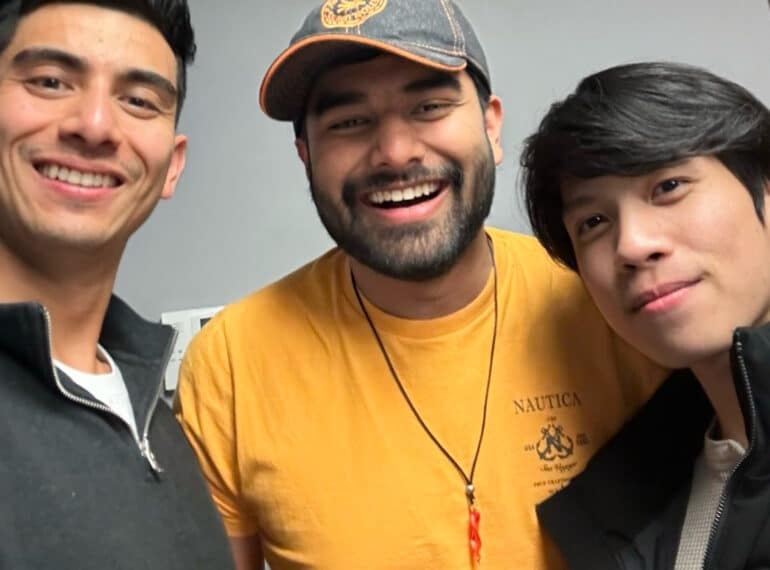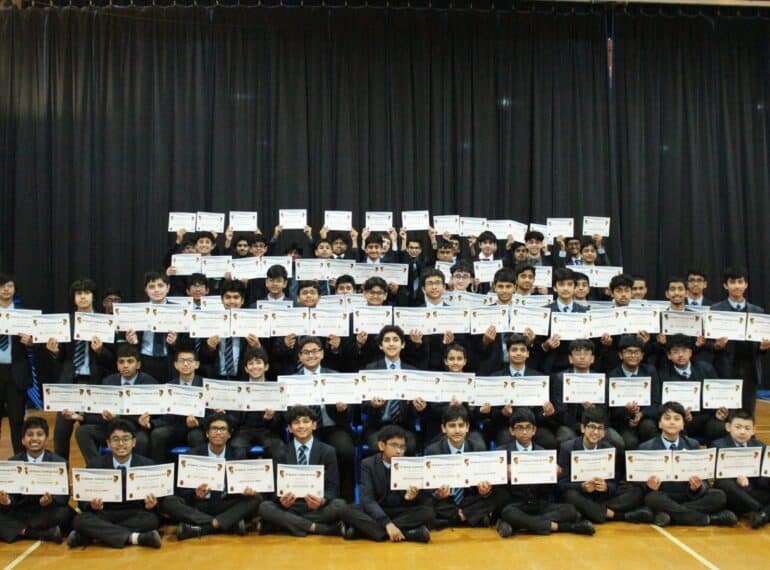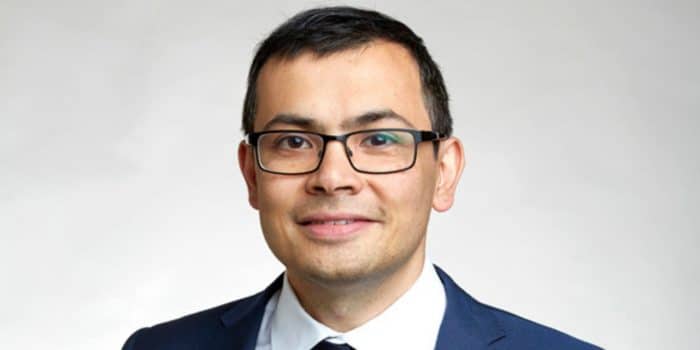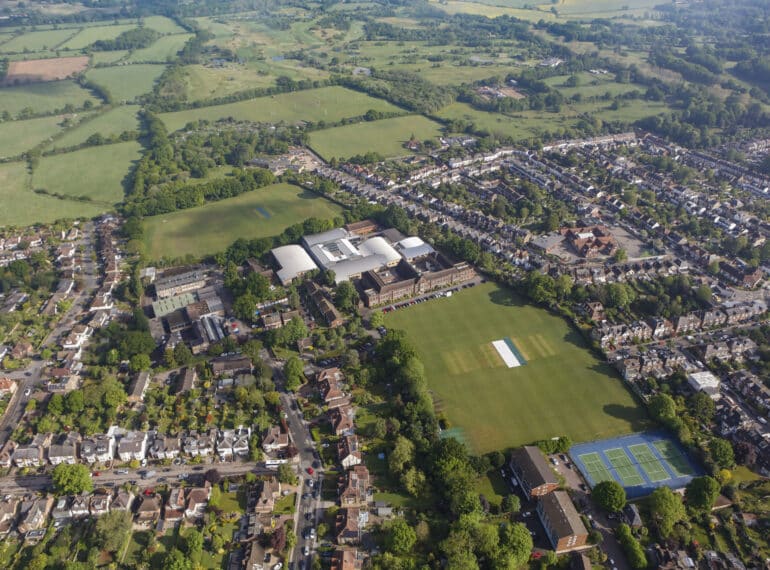
Three Old Elizabethan entrepreneurs in San Francisco have linked up and are now connecting with other alumni working in the world’s leading centre for technology companies.
Pavir Patel sent Headmaster Neil Enright the above photo of himself, Akshat Sharma and Richard Ou together in San Francisco. The three only discovered that they had the same alma mater through chance conversations, but, since then, they have created a group chat and have been expanding it to include more OEs in and around the Bay Area.
Mr Enright said: “Our alumni network has been growing rapidly in recent years, with leavers supporting each other, sharing professional opportunities and socialising together. Especially for alumni far from home, like Richard, Akshat and Pavir, it can be good to spend time with others who share a similar background. As a School, we are doing all we can to support such connections through our QE Connect social and business network.”
Richard (OE 2010–2015) said: “All three of us are founders looking to build billion-dollar companies in Silicon Valley. Quite a few QE boys that I’ve met in the US have been entrepreneurs, too, all having raised not so insignificant amounts of capital. It feels like we’re following in the footsteps of Demis Hassabis and Mustafa Suleyman, maybe a few years or a decade behind.” (Demis [OE 1988–1990] and Mustafa [1995–2002] were among the three co-founders of leading AI company DeepMind, formed in 2010.)
“What I am really excited about is more people from QE coming to the US. I think this is the place to be,” Richard added.
Pavir (OE 2003–2010) and Akshat (2012–2019) are part of the long-established international Entrepreneur First accelerator, which runs one of its four programmes in San Francisco. “However, they’d not met until after Pavir’s encounter with me,” says Richard. “I met Pavir at a FinTech AI hackathon hosted at the Digital Garage office in San Francisco. The conversation went something like this:”
Richard: “Where in the UK are you from?”
Pavir: “London, what about you?”
Richard: “I’m from London as well. Whereabouts?”
Pavir: “Stratford, and you?”
Richard: “Highgate”
Pavir: “I used to go to school up north of Highgate!”
Richard: “Really, where?”
Pavir: “QE Boys”
Richard: “Holy sh*t, I went to QE as well!”
Richard later met Akshat at the Entrepreneur First office.
As for Pavir and Akshat, they knew each other through being in the same accelerator, but did not realise the full extent of their connection until a conversation in a Waymo (self-driving car) turned to their backgrounds. “It was surreal,” said Akshat. “We were mates already and were speaking about our homes in the UK and school experiences…and there was a moment of realisation of ‘Wait a second – that sounds very familiar’ when we realised we both went to QE!”
 Richard said he realised even before going to university where he needed to be to pursue his goal of founding and growing a startup. “I knew that if I wanted to do it, the only place I could was the US. The problem was that education in the US was so expensive – four years of a degree course can easily be $250,000.”
Richard said he realised even before going to university where he needed to be to pursue his goal of founding and growing a startup. “I knew that if I wanted to do it, the only place I could was the US. The problem was that education in the US was so expensive – four years of a degree course can easily be $250,000.”
The solution he arrived at was to go to King’s College London, majoring in Physics (“my passion”) for his first degree and then come to the US for a Master’s degree at the University of Pennsylvania – “only two years!” He worked out some further ways to reduce the financial burden, including becoming a Resident Advisor (RA) – a peer mentor for other students – which comes with the major plus that free housing and food are provided.
The idea for his business came about when he graduated from ‘Penn.’ last year and was looking for a graduation photographer. “I realised it was really hard – there is not really any infrastructure for freelancing.”
With time on his hands, he worked out a plan for a business to put that right, checking that he had a Minimum Viable Business (MVB). He shared the plan with the photographer he had eventually found, Jerry Cai. “As soon as I pitched it to him, he said: ‘I want in.’”
The two became co-founders of Agorum, described on its website as “a freelancer marketplace connecting clients with skilled creatives”. They have started initially by focusing on freelancers who require a physical presence for their work – photographers, DJs and private chefs.
The process has not always been easy. “Funding was difficult at first. We tried raising funds last year when the economy was not doing very well.”
Since then, however, they have been scaling rapidly, and Richard is focused on taking the business global. Agorum was recently valued at $10m.
“I think what changed things was moving to the Bay area: I don’t think there is an eco-system like the Bay’s that exists anywhere else in the world.”
He acknowledged the help provided by his accelerator – VIP-X (different from Pavir’s and Akshat’s). VIP-X is run by the University of Pennsylvania’s Wharton business school and caters primarily for people associated with Penn. and Wharton. It takes no equity and offers what are essentially grants, not loans.
“I think one of the hardest parts of doing a startup is the loneliness and distance that comes with it,” said Richard. “Few people can relate.” In particular, he has found the constant need for absolute discretion about his plans for the business hard. “As the CEO, there is only so much you can ever say.”
“As my role has changed from managing a team of 1.5 people to now a team of ten, the problems are constantly evolving.”
“The thing is persistence,” Richard said, stressing the importance of listening to clients, who sometimes provide the only clue as to a way forward. “There is something about this gut instinct – and it usually comes from your customer. It becomes your driving force.”
Richard has no doubt as to the source of his strength. “When I look back at my time at QE, it was hard. A lot of homework and pressure. Retrospectively, that is what helped, giving me the resilience I am drawing on now. A lot of people have shared that with me, too. Things were always hard, but that raised your tolerance for a lot of things.”
 For his part, Akshat is currently building a company called Orbit. The sad truth about the current digital age is that “we have never been historically unhappier,” he said. “Orbit will empower people by making mental health as transparent and actionable as physical health through a non-invasive brain wearable. Orbit is unlocking cognition by building the first foundation model of the brain!”
For his part, Akshat is currently building a company called Orbit. The sad truth about the current digital age is that “we have never been historically unhappier,” he said. “Orbit will empower people by making mental health as transparent and actionable as physical health through a non-invasive brain wearable. Orbit is unlocking cognition by building the first foundation model of the brain!”
In addition to his work with Entrepreneur First, Akshat is part of the first cohort of Founders – the University of Cambridge’s own accelerator programme. He graduated from Cambridge in Biomedical Engineering last year, launching Orbit at the start of 2024.
“At the Neuro Optics Lab [in Cambridge], I developed the first, and only, brain computer interface using HD DOT, a novel imaging approach to track human brain function at comparable resolutions to an fMRI. This modality, being cheap, portable and high resolution, is uniquely positioned to create the foundation model of our brains!”
Akshat has won multiple awards at international conferences and is writing a first-author paper on the subject.
By leveraging the novel wearable technology, Orbit is focussing on making brain-tracking as simple and accessible as Fitbit made fitness-tracking – “all in the comfort of your favourite baseball cap or beanie!” as he put it.
“With each version, Orbit builds the largest, real-world brain data-sets to unlock new secrets about the way we perceive the world around us – our cognition. It starts by understanding mental workload and aims to progress to complex mental states, including anxiety, stress and depression. Each version helps us regain control of a new emotion, at each step regaining happiness through giving us a deeper understanding and control of our brain.”
 Finally, Pavir Patel’s business is Outerop. Like Akshat’s start-up, it launched at the beginning of this year. Outerop helps grow businesses online using AI, making it easier for them to build high-quality, reliable Large Language Model (LLM) products and to start creating self-optimising LLM pipelines (a series of steps where the output of one is the input of the other). Its slogan is: “Build GenAI products your customers love.”
Finally, Pavir Patel’s business is Outerop. Like Akshat’s start-up, it launched at the beginning of this year. Outerop helps grow businesses online using AI, making it easier for them to build high-quality, reliable Large Language Model (LLM) products and to start creating self-optimising LLM pipelines (a series of steps where the output of one is the input of the other). Its slogan is: “Build GenAI products your customers love.”
Since reading Economics at Nottingham, Pavir has, he said, “done all sorts – from incubating J P Morgan’s first AI startup doing NLP; setting up their FinTech team in Asia (Hong Kong was awesome!) and scaling Europe’s leading broker/crypto exchange, Bitpanda Pro, to spinning off a company with a Series A raise [a company’s first significant round of venture-capital financing] to launching an e-commerce business with my wife”.

 The boys were part of the winning inter-school ‘company’ at the weekend-long finals held at Imperial College London.
The boys were part of the winning inter-school ‘company’ at the weekend-long finals held at Imperial College London. Members of each company needed to work collaboratively to create a proposal in 22 hours, summarising all aspects of the settlement: operations, mission systems, structural, business, and human.
Members of each company needed to work collaboratively to create a proposal in 22 hours, summarising all aspects of the settlement: operations, mission systems, structural, business, and human.



 “In 2020, Demis Hassabis and John Jumper presented an AI model called AlphaFold2. With its help, they have been able to predict the structure of virtually all the 200 million proteins that researchers have identified.”
“In 2020, Demis Hassabis and John Jumper presented an AI model called AlphaFold2. With its help, they have been able to predict the structure of virtually all the 200 million proteins that researchers have identified.”
 Richard said he realised even before going to university where he needed to be to pursue his goal of founding and growing a startup. “I knew that if I wanted to do it, the only place I could was the US. The problem was that education in the US was so expensive – four years of a degree course can easily be $250,000.”
Richard said he realised even before going to university where he needed to be to pursue his goal of founding and growing a startup. “I knew that if I wanted to do it, the only place I could was the US. The problem was that education in the US was so expensive – four years of a degree course can easily be $250,000.” For his part, Akshat is currently building a company called
For his part, Akshat is currently building a company called  Finally, Pavir Patel’s business is
Finally, Pavir Patel’s business is 
 The high level of participation – the families of 526 pupils have signed up – has unlocked a £1,000 grant to the School from HomeRun. The money is being invested into QE’s Greenpower team, which builds electric racing cars.
The high level of participation – the families of 526 pupils have signed up – has unlocked a £1,000 grant to the School from HomeRun. The money is being invested into QE’s Greenpower team, which builds electric racing cars. “I know that there is much enthusiasm about the scheme among the families of our new Year 7 intake joining us in September, so there is scope to make even greater savings in the future. I hope that even more parents from other year groups will get involved.”
“I know that there is much enthusiasm about the scheme among the families of our new Year 7 intake joining us in September, so there is scope to make even greater savings in the future. I hope that even more parents from other year groups will get involved.” Finally, the HomeRun app creates a secure, dedicated space for people to share travel information. Those who opt in can connect with other families in their locality, since the app shows people how far away other users live, without revealing their actual address. It allows the School to update parents when boys will be ready to leave Queen’s Road outside the normal School day – after clubs and activities, for example, or when returning from a School trip.
Finally, the HomeRun app creates a secure, dedicated space for people to share travel information. Those who opt in can connect with other families in their locality, since the app shows people how far away other users live, without revealing their actual address. It allows the School to update parents when boys will be ready to leave Queen’s Road outside the normal School day – after clubs and activities, for example, or when returning from a School trip.